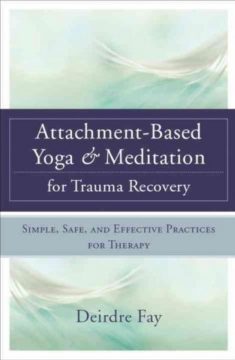Attachment-Based Yoga & Meditation for Trauma Recovery: Simple, Safe, and Effective Practices for Therapy by Deirdre Fay
Reviewed by Rose Kress
 I met Deirdre Fay several years ago when she came to take the LifeForce Yoga Practitioner Training. She had a depth and breadth of knowledge that was admirable and easy to understand, fun, and approachable. I found Attachment-Based Yoga & Meditation for Trauma Recovery to be just like Deirdre: deep and expansive in its wisdom, while being easy to understand, fun, and approachable. This was not a quick read, instead, I wanted to savor the information, re-read pieces and even full chapters. Coming in at just over 300 hundred pages, this book is both a tome and a treasure, to be savored again and again.
I met Deirdre Fay several years ago when she came to take the LifeForce Yoga Practitioner Training. She had a depth and breadth of knowledge that was admirable and easy to understand, fun, and approachable. I found Attachment-Based Yoga & Meditation for Trauma Recovery to be just like Deirdre: deep and expansive in its wisdom, while being easy to understand, fun, and approachable. This was not a quick read, instead, I wanted to savor the information, re-read pieces and even full chapters. Coming in at just over 300 hundred pages, this book is both a tome and a treasure, to be savored again and again.
Fay begins the journey of this work from the perspective of her personal history – a time when her own trauma erupted. She was at Kripalu in its ashram days (a spiritual and religious retreat), practicing yoga and meditation when her own trauma reared its head. She went from being active, engaged, and the experience of herself as bliss and clarity, to disconnected, terrified, and numb. This experience, which may be familiar to many readers, led Fay to discover the intersections between social work, attachment theory, yoga, and mindfulness. Attachment-Based Yoga & Meditation for Trauma Recovery, is the culmination of her exploration and work, thus far.
Fay moves through outlining attachment theory and yoga philosophy (Chapter 1), into a discussion of shame and the need to develop compassion as a buffer for shame (Chapter 2). The preceding chapters set up a secure base for exploring practices that invite “Safe Embodiment,” entering the body in a way that feels safe (Chapter 3). As one moves deeper into the exploration of patterns and personal history, dissociation often arises as a means of self-protection. Fay provides history, tools, and techniques to “disarm dissociation with presence” (Chapter 4). Chapter 5 provides insight into managing triggered responses and ultimately disarming them. Fay then moves into a discussion on boundaries; specifically, the psychic boundary between Self and Other (Chapter 6). Fay ends with a chapter on establishing trust, where “we look into what’s possible, trusting prana [Sanskrit for life force energy] to access individual wisdom as a means of secure internal attachment and to find each particular person’s path home to their Self” (xvi). Every chapter ends instructions for practices mentioned and/or outlined within the chapter. There are practice for meditation, yoga, psychoeducation, journaling, experiencing, etc.
Particularly illuminating for me was the discussion of Attachment Theory. From the forward by Germer, “everyone needs a safe, secure base from which to explore the world, especially in times of stress.” When the safe and secure base is not established in childhood, due to trauma, individuals can retreat in times of need. The model of attachment therapy is to begin to create a safe and secure base in the therapy room that eventually creates the safe and secure base within the client. “The compassionate self-to-other relationship gradually becomes a compassionate self-to-self relationship” (Germer). Moving through the process of healing from trauma and creating secure attachments to Self is difficult to do alone. “What was broken in connection needs to be repaired in connection” (Fosha). Fay outlines the pathway of attachment theory as re-establishing that connections, through present moment awareness and healthy relationships with a guide, the body, and Self.
This work is accessible, peppered with supporting research and client anecdotes. There is also a depth to this book that may make you want to dive in, or revisit certain sections for greater understanding. Personal patterns may be illuminated and finally understood as you make your way through these pages. You might even walk away with a deeper understanding of trauma and greater compassion for those around. This is a fantastic resource for professionals AND laypersons.
Order your copy here.